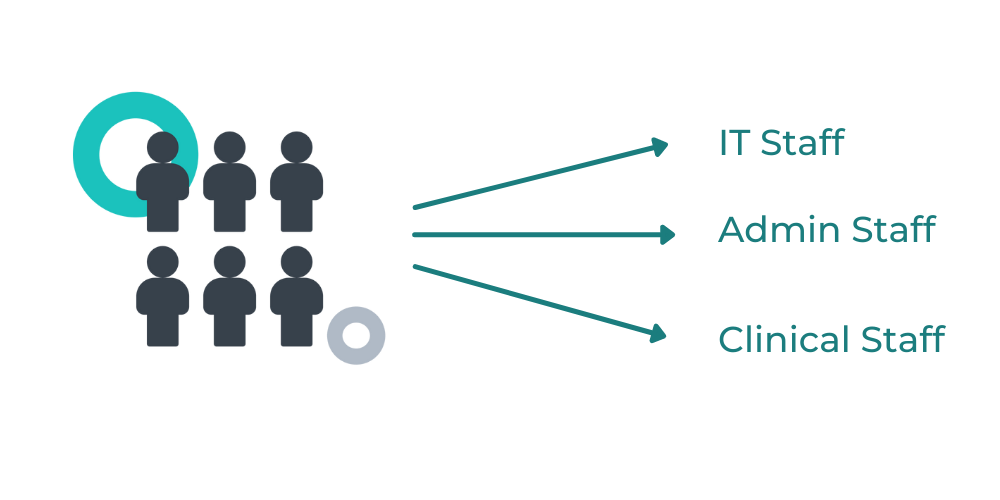5-Stage Process For Implementing Video Telehealth
Rolling out video telehealth for the first time can be challenging, particularly for medium and large healthcare organisations. It often requires a structured and well-tested approach to ensure that the rollout is as smooth as possible for all parties involved, including clients, patients, and all clinical and non-clinical staff.
During the COVID-19 pandemic, Coviu has worked with numerous health and social care organisations to support them in their video telehealth roll-out. None of these organisations have used telehealth before the pandemic and their learning curve was steep and fast. To optimally support these organisations and ensure a frictionless transition, Coviu developed a 5-stage process, underpinned by change management strategies, to guide the implementation of the platform.
Stage 1 - Create an Implementation Team
 Create an implementation team that includes all key decision-makers, and nominate a project lead for the rollout. It is important that the team consists of all the different stakeholders, including IT, practitioners, and administrators. Often people miss out on inviting administrators. But administrators are the backbone of a telehealth system.
Create an implementation team that includes all key decision-makers, and nominate a project lead for the rollout. It is important that the team consists of all the different stakeholders, including IT, practitioners, and administrators. Often people miss out on inviting administrators. But administrators are the backbone of a telehealth system.
The implementation team needs to be well briefed on the rationale for implementing telehealth and be able to articulate the value proposition throughout the organisation including why video calls are better than a phone call.
During lockdown periods telehealth was primarily deployed to reduce infection risks and keep services operating. But those who saw telehealth as part of their long term models of care described rationales such as;
-
being able to provide more patient-centered care by offering services into the home
-
expanding their organisational footprint by providing telehealth services into new geographical areas, particularly those underserved.
-
Or it can be about staff efficiencies - wanting to enable staff members with specific expertise within their organisation to provide care in areas where there are not sufficient resources, or demand to have those members of staff on the ground.
Once the implementation team is formed and is well briefed on the rationale of using Coviu, it is important to develop an implementation plan. For enterprise clients, Coviu provides a detailed template with all the tasks required for implementation that organisations can amend.
Stage 2 - Develop Platform Structure
In the second stage, organisations start to develop their platform structure. Coviu aims to take an organisation’s structure and replicate it virtually. On the platform, you can have numerous organisations and clinics. For example, you may have an organisation for each state or city. This organisation can contain several clinics. Just like a bricks-and-mortar building, each clinic has a separate waiting area, individual practitioner rooms, and team meeting rooms. Trailing the platform structure with different users ensures the correct structure is chosen.
Stage 3 - Co-design Workflows with Frontline Staff
.jpg?width=1000&name=IT%20Staff%20(1).jpg)
The importance of co-designing these workflows with staff members who will be the ones using them cannot be underestimated. Because Coviu has been designed specifically for a health care environment, it has rich capabilities to support the administration of a telehealth consultation such as booking, scheduling, and taking payments. Understanding which tools available within the platform will support a practitioner to deliver the best consultation possible by telehealth and optimise the use of the platform can be an iterative process.
Consulting widely to establish workflows that embed telehealth into everyday care will be time well spent. It enables organisations to become more fluid in their use of telehealth and get to the point where models of care are hybrids of in-person and telehealth appointments.
Ensuring that workflows are agreed with those who use them, rather than being decided for them, is of key importance and helps ensure that staff have a good experience the first time they use the platform.
Stage 4 - Training
.jpg?width=1000&name=IT%20Staff%20(2).jpg)
A robust training program ensures that staff are confident with using telehealth and can deliver the same quality of care as in-person therapy using the technology.
At Coviu, we employed a variety of training models, depending on what was most suited to each customer. Training the trainer was employed by a number of organisations. This is most successful when the telehealth coordinator is the training lead as they quickly develop a deep knowledge of the platform.
With another organisation we recorded bespoke training videos that were sent to over a thousand staff members. Coviu now has a whole suite of professionally made training videos.
There were examples of craft groups trained together to understand how they were going to modify their practice for the online environment.
Others training was in multi-disciplinary groups with administrators. Whichever training model was used the most important factor is to give people access to the platform and encourage practice calls with colleagues. Experiential learning is really important.
Training is not just about showing people how to pick up a call. It is also about building people’s confidence and competency. For example, explaining how to troubleshoot minor glitches such as missing audio or video. It is about being able to establish a good rapport with patients and feeling comfortable with the online environment. Hybrid models of care are here to stay and we need to continue supporting practitioners to develop their skill set for online consultations.
Stage 5-Rollout
.jpg?width=5946&name=Coviu-adobestock_282004507%20(4).jpg)
The time for each organisation to get to this final stage may vary. Time spent in stages 1 - 3 is highly valuable to ensure a successful rollout. In particular stage 1, creating the right team and clearly articulating the value proposition to all staff is key. It is easy not to spend time on these issues, but rather just focus on the technology. But technology is only one part of implementation - it's a journey and you need to bring people along with you.
Ongoing evaluation of telehealth is required. The platform provides many reports on its use, but resending the surveying staff at 3 and 6 months post-implementation will help you plan for training, quality improvement and inform KPIs.
Conclusion
Overall, organisations that have utilised the 5-stage implementation process have been successful in rolling out telehealth, particularly during the stressful time of the pandemic. For most organisations, video telehealth became embedded into their long-term strategy.
Selecting the right implementation approach and getting the right support from the platform provider can have a major impact on the short and long-term success of the rollout.



)%20(Presentation%20(169))%20(5)-1.png)
